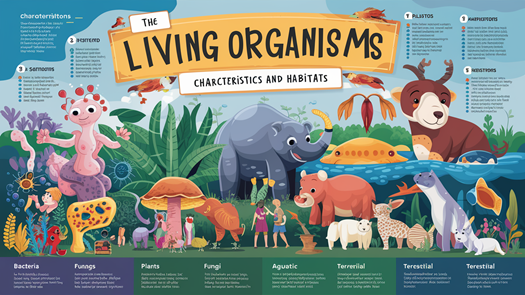
Class 6 Science Chapter 6 – The Living Organisms Characteristics and Habitats
NCERT Solutions for Class 6 Science Chapter 9 – The Living Organisms Characteristics and Habitats
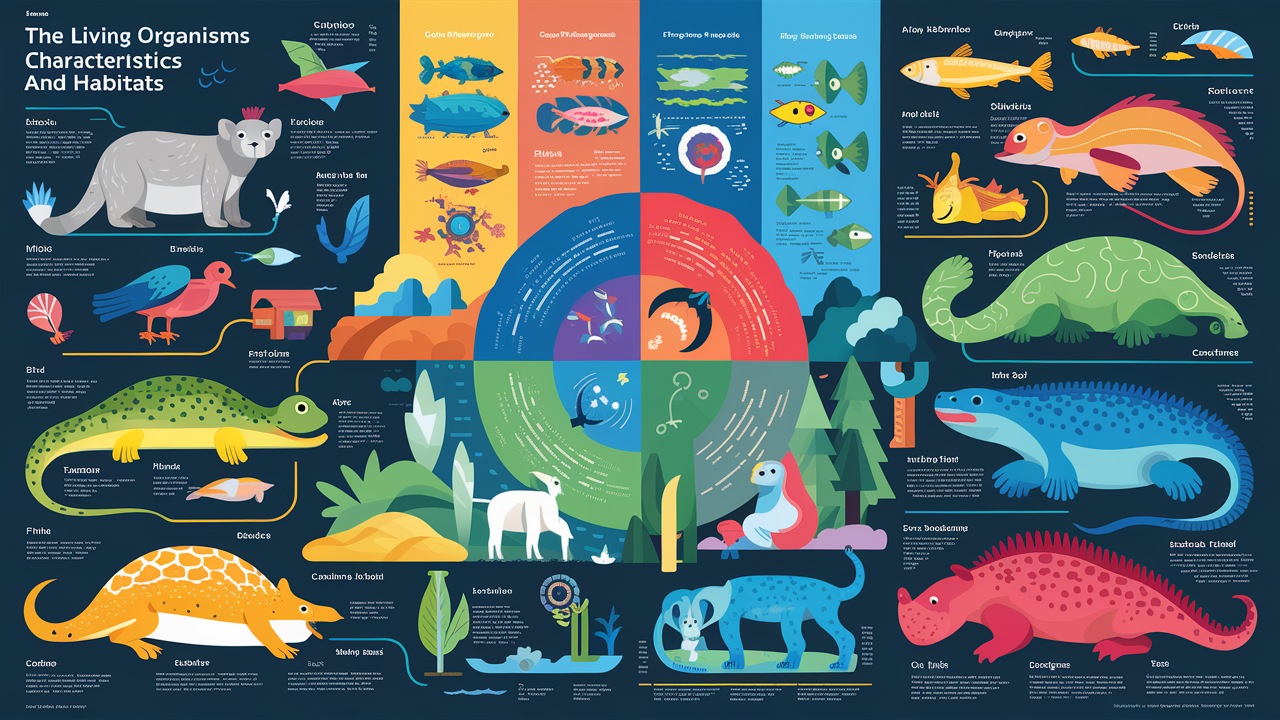
We all are surrounded by plants, trees, animals, birds, microbes, and other living and nonliving things based on certain parameters, Scientists were able to differentiate between living and nonliving things.
Organisms
An organism is simply defined as any living thing, ranging from microscopic bacteria to large elephants and everything in between.
- Different types of plants and animals are found in different areas.
- E.g. deserts have camel and cacti as plants.
- Beaches show coconut trees and crabs.
- Fishes and other marine animals inhabit the sea.
Characteristics of Living Organisms
- Plants are living things, but they do not appear to move like a dog or a pigeon.
- On the other hand, a car or a bus can move, yet we consider them as non-living.
- So there are certain characteristics that differentiate living from nonliving-
- Living beings are made of cells.
- Living beings obtain and use energy.
- Living beings grow and develop.
- Living beings reproduce.
- Living beings adapt to their environment.
- Living beings respond to their environment or stimuli.
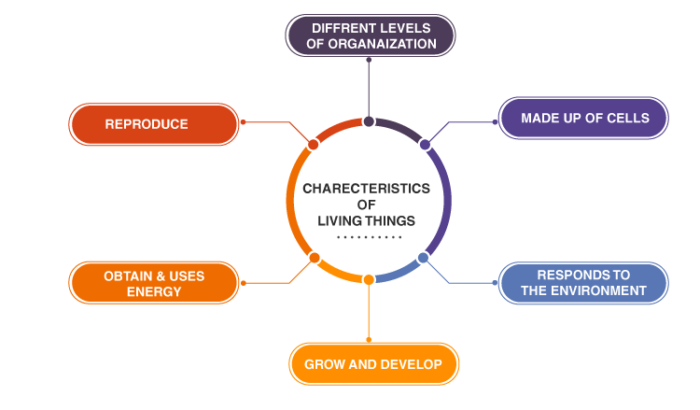
Let’s explore the important characteristics of living organisms one by one.
Nutrition
- The process by which animals obtain food and utilize it for all activities is called nutrition.
- Every organism requires nutrition to obtain energy.
Growth
- All living organisms grow and exhibit growth in different ways.
- Their body cells divide and grow, and thus overall growth is attained.
Respiration
- Respiration is necessary for all living organisms.
- It is through respiration that the body finally obtains energy from the food it takes.
- Some animals may have different mechanisms for the exchange of gases, which is a part of the respiration process.
- E.g. earthworms breathe through their skin, and fish have gills for using oxygen dissolved in water.
- In humans, we respire by breathing in oxygen and breathing out carbon dioxide.
Response to Stimulus
- Changes in our surroundings that makes us respond to them are called stimuli.
- All living beings react to changes in their surroundings.
- E.g. In response to increased temperatures in summer, we use fans to cool our homes.
Excretion
- All living things take food.
- Not all the food that is eaten is really used. Only a part of it is utilised by the body.
- Unused/remaining food becomes waste and needs to be excreted.
- Our body also produces some waste, like urea, in other life processes.
- Living organisms get rid of all this waste material, and the process is known as excretion.
Reproduction
- All living organisms give rise to a new organism of their own kind by a process called reproduction.
- The mode of reproduction may be different in different animals and plants.
- Some animals produce their young through eggs.
- Some animals give birth to young ones.
- Plants produce seeds which germinate into new plants.
- Some plants also reproduce through parts other than seeds.
- E.g, a part of a potato with a bud grows into a new plant
Movement
- Animals move from one place to another and also show other body movements.
- Plants are generally anchored in the soil so they do not move from one place to another.
- However, various substances like water, minerals and the food synthesised by the plants move from one part to other.
- Plants also show other kinds of movement, like the opening and closing of flower buds.
Animal Adaptation
Adaptation
The presence of specific features or certain habits, which enable a plant or an animal to live in its surroundings, is called adaptation.
- Different animals are adapted to their surroundings in different ways.
- For example, Fish have slippery scales on their bodies.
- These scales protect the fish and also help in easy movement through the water.
Habitats
Surroundings
- The different surroundings or areas have different organisms that live in them.
- E.g., The deserts have camels, the mountains have goats and yak.
Habitat
The surrounding where living organisms survive is known as the habitat.
- The organisms depend on their habitat for their food, water, air, shelter and other needs.
- Habitat means a dwelling place (a home).
- Several kinds of plants and animals may share the same habitat.
Biotic Components
- The living components of a habitat are called biotic components.
- For example, plants and animals
Abiotic Components
- The non-living components of a habitat are called abiotic components.
- For example, rocks, soil, air, water etc
Terrestrial Habitats
- The plants and animals that live on land are said to live in terrestrial habitats.
- For example, forests, grasslands, deserts, coastal and mountain regions.
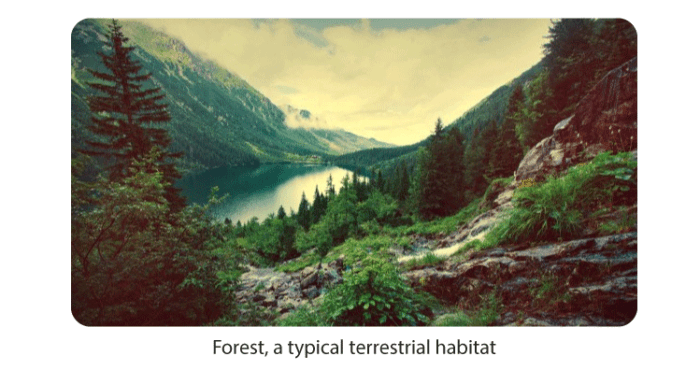
Aquatic Habitats
- The habitats of plants and animals that live in water are called aquatic habitats.
- For example, ponds, swamps, lakes, rivers and oceans.
- Aquatic habitats could be freshwater (river, pond) or marine (sea) or even estuarine (delta of river meeting with the sea)
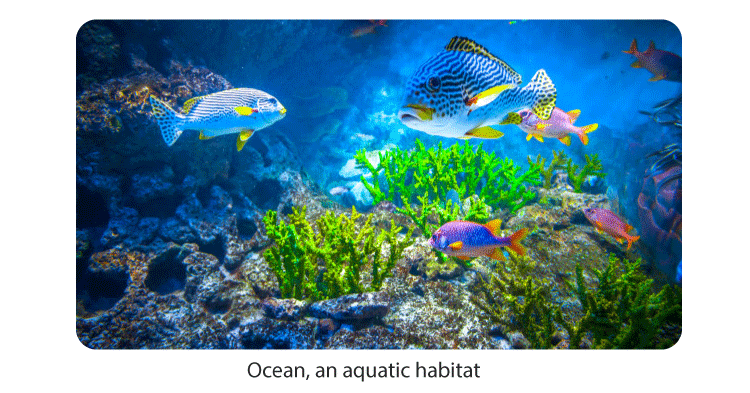
Exercise Questions- Answer
- What is a habitat?
Solution:
The place where organisms live is called the habitat. Habitat means a dwelling place (a home). The habitat provides food, water, air, shelter and other needs to organisms.
- How is a cactus adapted to survive in a desert?
Solution:
Adaptations of a cactus are as follows:
- The leaf is replaced by the spine to reduce transpiration
- Stems carry out photosynthesis
- A thick waxy layer surrounds the leaf to retain water
- The roots of a cactus are deeply rooted inside the soil to absorb water
- Fill in the blanks
(a) The presence of specific features, which enable a plant or an animal to live in a particular habitat, is called ————.
(b) The habitats of the plants and animals that live on land are called ———— habitat.
(c) The habitats of plants and animals that live in water are called ————habitats.
(d) Soil, water and air are the ———— factors of a habitat.
(e) Changes in our surroundings that make us respond to them are called ————.
Solution:
(a) The presence of specific features, which enable a plant or an animal to live in a particular habitat, is called adaptation.
(b) The habitats of the plants and animals that live on land are called terrestrial habitats.
(c) The habitats of plants and animals that live in water are called aquatic habitats.
(d) Soil, water and air are the abiotic factors of a habitat.
(e) Changes in our surroundings that make us respond to them are called stimuli.
- Which of the things in the following list are nonliving?
Plough, mushroom, sewing machine, radio, boat, water hyacinth, earthworm
Solution:
Plough, radio, sewing machine, and boat are nonliving things
- Give an example of a nonliving thing which shows any two characteristics of living things.
Solution:
Example: car
Features
- It can move like living beings
- It needs energy to do work
- Which of the nonliving things listed below were once part of a living thing?
Butter, Solid, Leather, wool, cooking oil, electric bulb, salt, rubber, apple
Solution:
Butter, wool, leather, cooking oil, rubber, and apple were once part of a living thing.
- List the common characteristics of living things.
Solution:
Common characteristics of living things are as follows:
- i)Respiration
- ii)Food intake
iii) Respond to stimuli
- iv)Excretion
- v)Movement
- vi)Reproduction
vii) Grow and die
- Explain why speed is important for survival in the grasslands for animals that live there. (Hint: There are few trees or places for animals to hide in grassland habitats.)
Solution:
Speed is important for survival in the grasslands for animals to avoid predation from their predators. For example, a tiger eats deer; to survive, the deer has to run faster than the tiger.
Please Visit: Readspot

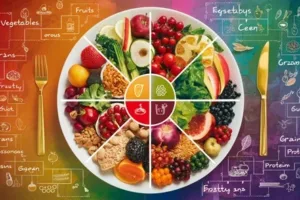

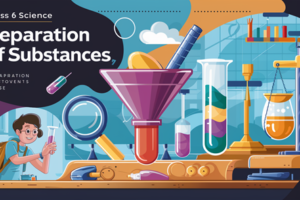
3 Comments
I learned a lot from this article—it was written in such an engaging
way! The site’s design is sleek and modern.
Познавательно и доступно написано, спасибо за качественный контент!
Лисички био-чистка уничтожает паразитов и
восстанавливает организм широкий спектр действия обеспечивает 100% эффективность:
Уничтожает все известные виды паразитов
Помогает очищению органов и тканей, нейтрализует интоксикацию вследствие паразитарной инфекции
Регенерирует слизистые, очищает кровь, лимфу, межклеточные
жидкости
Нормализует окислительно-
восстановительное равновесие, угрожающее образованием онкоклеток
Повышает иммунный статус и сопротивляемость организма
Восстанавливает и нормализует функции угнетенных
органов, приводит в порядок гормональный фон
Заживляет механические повреждения, полученные в результате
жизнедеятельности глистов
Устраняет язвы, боли, спазмы гладкой
мускулатуры.